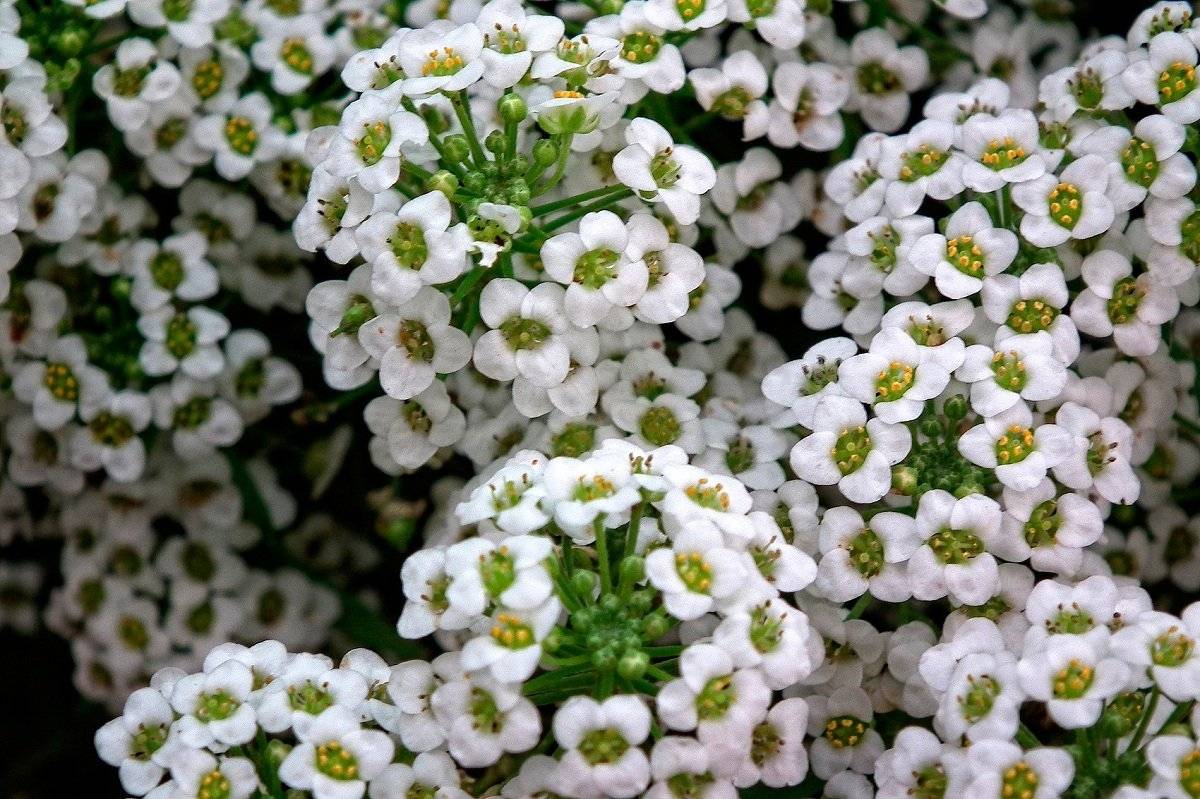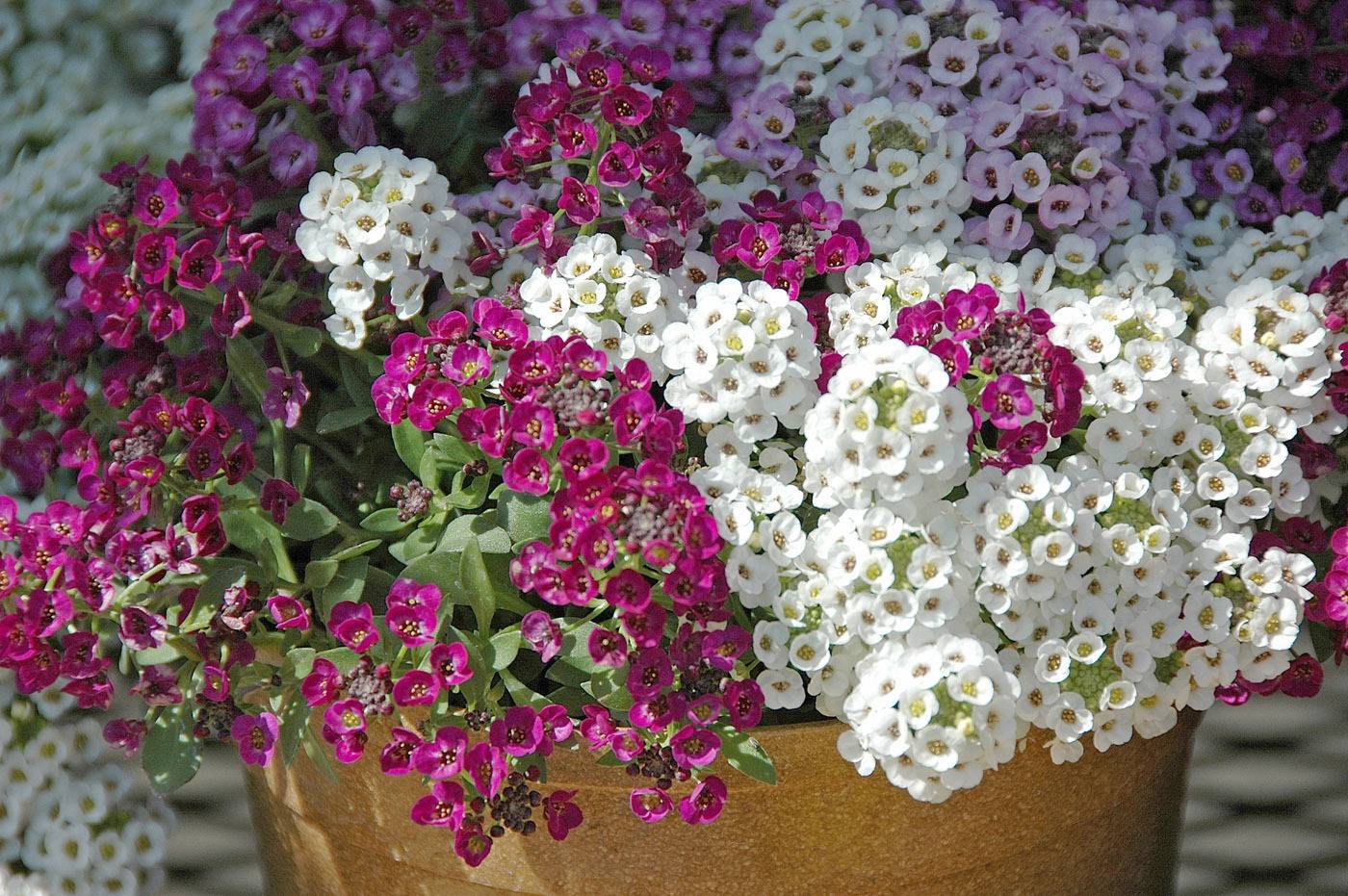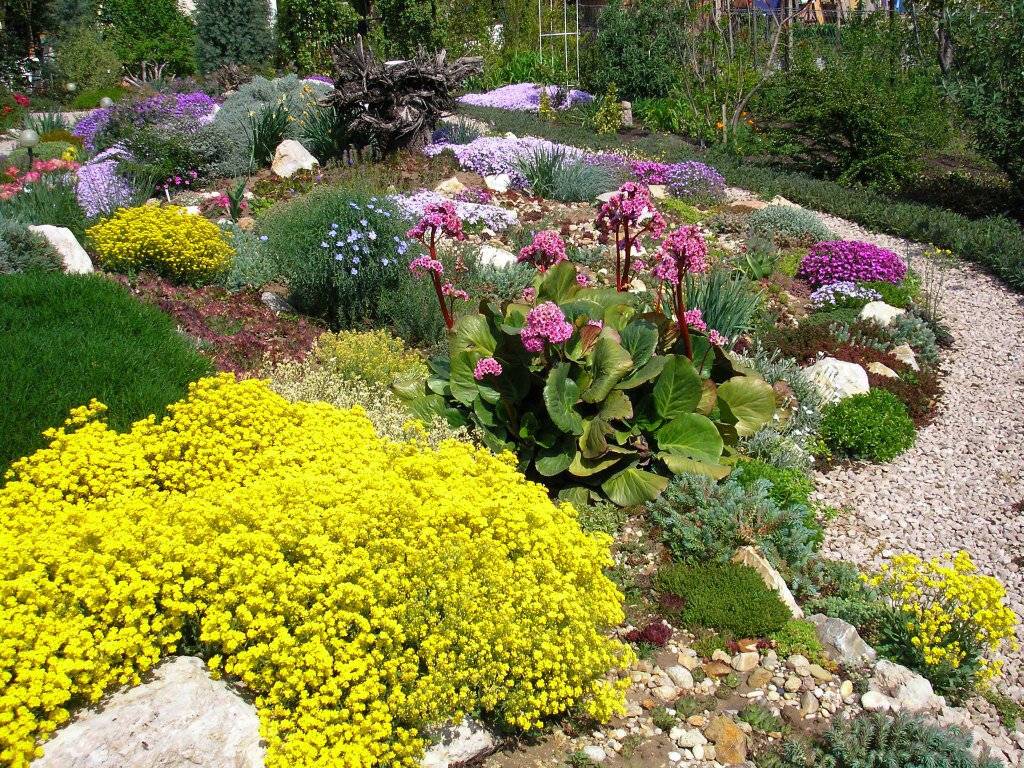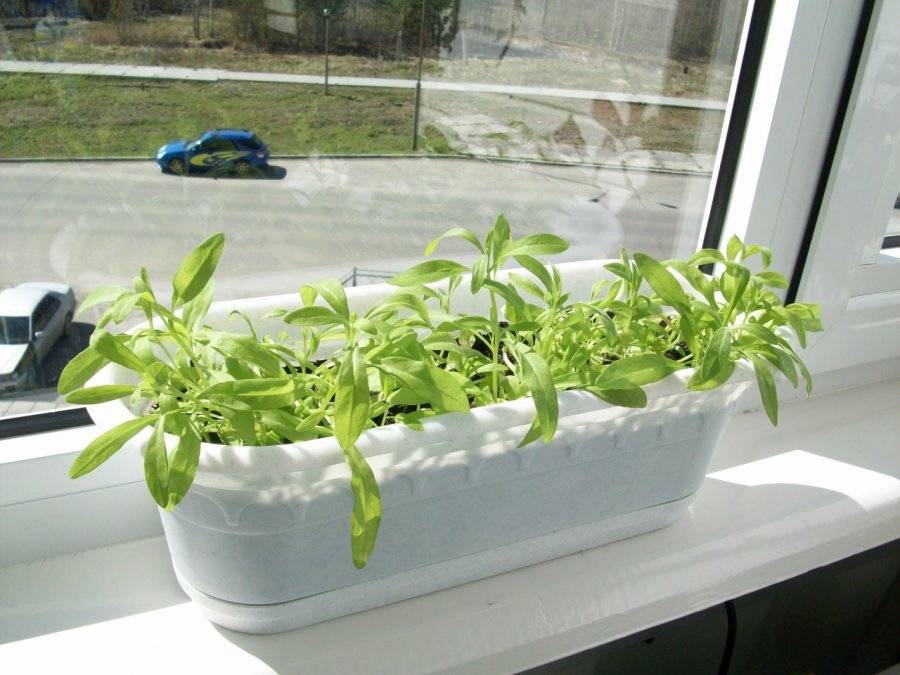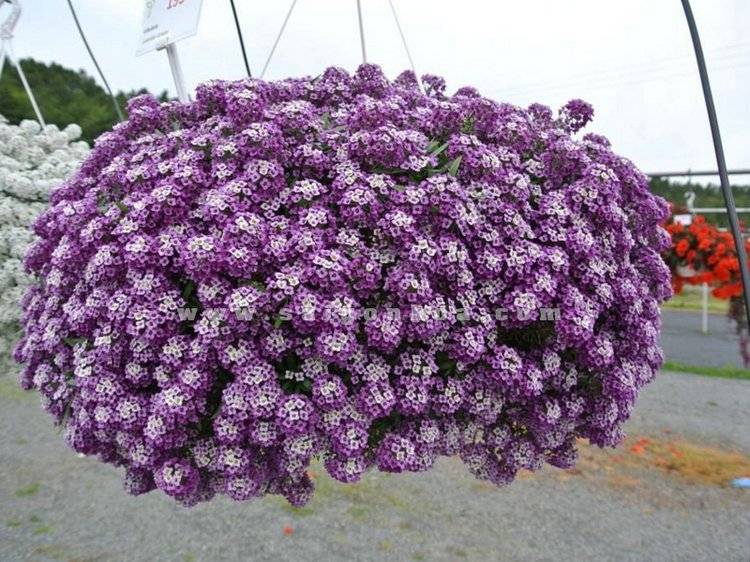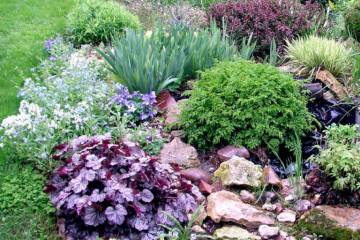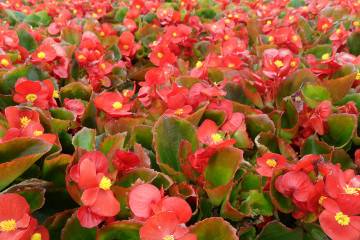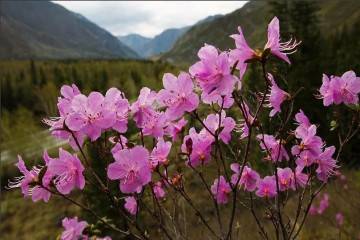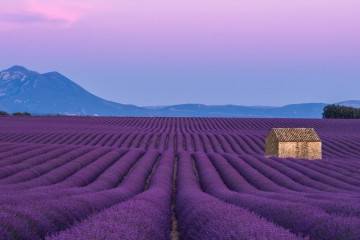Alissum flowers
Content:
In gardens and parks, whole glades are covered with variegated carpets of small flowers. These herbaceous alyssum flowers are held in high esteem by florists. Unpretentious to care for, they multiply easily. The palette of colors includes the entire spectrum - from white to dark purple.
Alyssium - flowers for the garden
Alyssum - perennial or annual - undersized culture with miniature flowers. The description begins with their subtle honey aroma, which they exude in the sunset hours. In everyday life, the flower is called lobularia or beetroot. Many people know it as a stonemason.
The flower is decorated with oval leaves, noticeably pubescent. The plant is ground cover, undersized. Shoots at the base are lignified, strongly branching. They grow to a height of 35-40 cm. Flowers are collected in clusters.
Perennial alyssum is grown in park beds, ridges. In pots and on balconies - annual. The plant is decorated with rocky hills, curbs. The combination with viols is especially effective. Before flowering, the stone mason covers the ground with a dense green carpet. From May to autumn it blooms in waves, during the season it does not lose its decorative properties.
Types and varieties of alissum
More than 200 varieties are known to botanists. The most popular types of perennial or annual alyssum for gardening:
- Alissum mountain. Perennial, height up to 10 cm. Gray leaves densely cover the soil. Yellow flowers rise above them. They begin to bloom early, in April. Flowering lasts a month. In place of flowers, ugly boxes are formed. They are pruned to keep the flower bed attractive.
- Alyssum marine. Annual with gray lanceolate leaves. They have a light fluff on them. Height 20 cm. Flowers purple, white, pink, lilac. Violent flowering begins in July and lasts until late autumn. The culture grows well in rocky coastal areas.
- Gold placer is a spherical bush. Leaves and shoots spread along the ground. The flowers are bright yellow, the flowering period is long.
- Snow carpet is a strong scent. At the moment of flowering, the ground seems to be covered with white foam.
- Alyssum bimbo white is a favorite variety of florists. Blooms densely throughout the season.
- Purple haze. Height 15 cm forms a purple cover. Long flowering.
Alyssum flowers are used in the landscape of gardens, parks: for framing flower beds, planted between slabs of paths, on rocky hills.
Alyssum landing
Annual or perennial alissum - growing flowers begins with the collection of seeds. After flowering, oblong pods are formed on the bushes. They are collected.
Seed collection
For collection in September-October, a cloth or film is spread under the bushes. Grind dried seed fruits right on the spot. Large fragments are removed. Seeds (very small) are collected in a linen bag. Store in a dry, ventilated, draft-free room. Germination lasts 2 years.
If it was not possible to collect the seeds, and they crumbled, they are swept out from under the bush with a broom. Collect on a cloth, get rid of large debris.
Planting seeds
Small seeds cannot germinate. Therefore, they are sown for seedlings directly in containers. Nutrient soil is poured into a shallow container, moistened. The soil should contain a small amount of lime. Seeds are also sown in peat tablets.
Soak in a disinfecting solution.Put it on the surface with tweezers or a toothpick, press down with a dry hand or spoon. Cover with glass or film, put in a warm place - 18-20 ° C.
The procedure at home is done at the end of winter. If there is not enough light, the landing is illuminated with an LED lamp. The earth is carefully sprayed or watered into a pan.
Transplanting seedlings
Seeds germinate in 12-15 days. When 4 true leaves appear, the seedlings dive. Transplanted into separate containers, or thinned out. Dense seedlings will soon begin to interfere with each other, become thinner, and stunted. Places for a dive are required 4 times more. Therefore, bulk boxes with a substrate are stocked up.
Seedlings are planted in rows, at a distance of 2-3 cm. If it is still far away before planting in open ground, they are seated further away.
Dived plants need watering, spraying. They are hardened, fed with means for flower seedlings. Hardening begins with 15-20 minutes in the fresh air. Every day the time is increased by half an hour.
There should be enough heat and light so that the beetroot does not stretch out, does not become thinner.
Alyssum flower: planting and care in the open field
Planting this flower in open ground and caring for it is not difficult. Choose well-lit areas of the garden. Scattered partial shade also does not harm the flower. The plant tolerates frosty winters, but also easily adapts to dry air. An important condition is that the place must be ventilated.
Natural large stones are left. Lobularia loves to grow near them. During the day, they warm up, the roots receive strength for growth. This is an imitation of the wild growth of a flower.
A damp shady valley is a poor place for a flower.
Soil requirement:
- fertility;
- ease;
- good drainage;
- neutrality.
Alyssum is planted at the end of April, May. Seedlings are transferred to open ground.
Procedure step by step:
- The distance between plantings is 30-40 cm. It is taken into account that the stonemason can grow widely.
- The selected place is dug up, freed from debris. Leveling.
- Seedlings are immersed in water along with a container to make it easier to remove from it.
- Dig a hole the size of an earthen lump of a pot.
- The hole is watered.
- Seedlings are removed together with the ground, placed in a hole.
- Sprinkle with soil, watered.
Reproduction of alissum
The stonemason is propagated in several ways. The plant gratefully responds to care, easily takes root in a new place.
Dividing the bush
The division procedure is carried out in May before flowering. The bush is dug up. A hole is made in the chosen place, filled with water. The dug bush is divided, the cut is planted in a hole, covered with earth, squeezed with fingers.
The plant almost does not bush, so there is a chance to spoil the bush by division.
Propagation by cuttings
The flower branches strongly. In the spring, shoots are cut off, not thrown away. Cuttings are placed in a bowl with peat and sand, watered. Cover with a bag or glass. When the cuttings give roots, this will be visible at the top. She will come to life, start to grow. They are transplanted to a new place.
Cuttings can be planted immediately in the garden. The lower part of the cut stem is sprinkled with earth, watered. Press the soil tightly, cover the cutting with a glass jar or plastic bottle. Water often, little by little.
Self seeding
This method is best suited for annual alissum. Ripe seed pods are not removed. For the winter, the plant is left in a flower bed.
In the spring, the old bushes are pulled out, the flowerbed is ennobled. There is no need to sow - last year's seeds attacked. The plot is watered. Shoots appear friendly, dense. When they get stronger, they thin out. Seedlings can be planted in another place, or in flowerpots, pots.
Outdoor care for alyssum
Alyssum flower, planting and care in the open field of which does not cause much trouble, is highly valued by florists.
Alyssum care includes:
- Weeding and loosening the soil.
- Watering when the soil is dry to a depth of 3 cm. Moisten moderately. The plant will get wet if watered too abundantly. It tolerates drought more easily. When it rains in summer, no irrigation is required.
- Fertilizer. It is enough to feed perennial species with a nitrogenous composition in spring for the development of the vegetative organs of alyssum. Annuals are fed 4 times per season. The first time to grow the leaf is watered with nitrogen fertilizer. Then - complex with potassium and phosphorus.
- Pruning when the branches dry out and wither. Shorten by 5 cm. Perennials should be trimmed 1/3 of their length. In order for the flower bed not to lose its aesthetic appearance, the plants should look beautiful. Therefore, the faded inflorescences are cut off.
Possible growing difficulties
If the alissum does not bloom, it begins to dry, they are looking for the reason why the culture is disappearing. It may have been attacked by a cruciferous flea. Deliverance - 1 tbsp. l. vinegar essence, diluted in a bucket of water. Only mature plants are sprayed.
Other problems:
- Caterpillars annoy plants. The bushes are treated with chamomile or tobacco infusion with soap.
- Cabbage moths and whites are destroyed by preparations of entobacterin and lepidocide.
- If the soil does not allow moisture to pass through well, a brown rot disease appears - late blight. It attacks the roots. They are treated with fungicides.
- Lobularia can get powdery mildew - sprayed with Bordeaux liquid.
- More difficult with a viral mosaic. The leaves are covered with spots of white and green. This is not cured - the bush is pulled out by the roots, burned.
In the world of decorative flora, alissum takes pride of place. It is a herbaceous groundcover with small flowers. There are many colors. It can be multi-year and one-year development. It is not difficult to plant and care for - it multiplies by self-seeding (annuals), cuttings, dividing bushes. Seedlings are grown from seeds.
Keeping an eye on a flower is simple: watering, pruning, feeding, pest treatment. Growing and caring for alyssum is available to novice growers.
